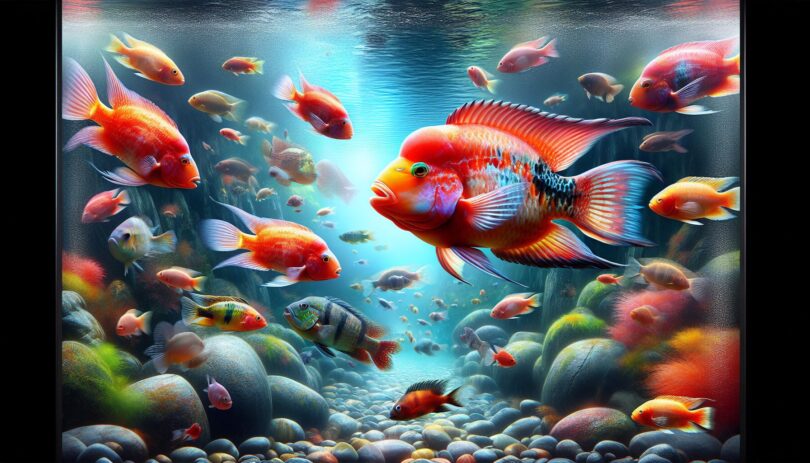Blood Parrot Cichlid, a vibrant splash of color in the aquatic world, has captured my fascination and that of many aquarium enthusiasts. This unique fish, with its distinct shape and bright hues, stands out in any aquarium. But don’t let its beauty fool you; there’s more to the Blood Parrot Cichlid than meets the eye.
Created through the crossbreeding of different Cichlid species, this hybrid fish has sparked controversy and admiration alike. Despite the debates surrounding their origin, I’ve found that their playful personality and the lively ambiance they bring to tanks make them a captivating subject for any fish lover. Let’s dive into the intriguing world of Blood Parrot Cichlids and discover what makes them such a fascinating addition to your aquatic family.
Key Takeaways
- Blood Parrot Cichlids are a vibrant and controversial hybrid species, created from the crossbreeding of different cichlids, with a distinctive appearance and playful personality that make them popular in home aquariums despite ethical debates concerning their breeding.
- These cichlids are known for their intense coloration that can range from bright oranges to deep reds and unique physical features like their rounded body and beak-like mouth, which pose feeding challenges and contribute to the controversy surrounding their ethical breeding.
- Proper care for Blood Parrot Cichlids includes maintaining optimal water quality and temperature, providing a spacious tank with hiding spots, supplying a balanced diet suited to their unique mouth shape, and ensuring peaceful tank companions to mitigate territorial behaviors.
- The selection of compatible tank mates is crucial for creating a harmonious environment, with mid-sized, peaceful fish and larger, peaceful bottom-dwellers being ideal companions to accommodate the Blood Parrot Cichlid’s temperament and size.
- Breeding Blood Parrot Cichlids presents challenges due to their potential sterility, but success can be achieved through creating an appropriate environment and with patience, though ethical considerations should be taken into account.
- Preventing common health issues in Blood Parrot Cichlids, such as Ich, Swim Bladder Disorder, and Skin and Fin Rot, requires vigilant care, including managing water quality, providing a balanced diet, and ensuring stable environmental conditions.
Origins of the Blood Parrot Cichlid
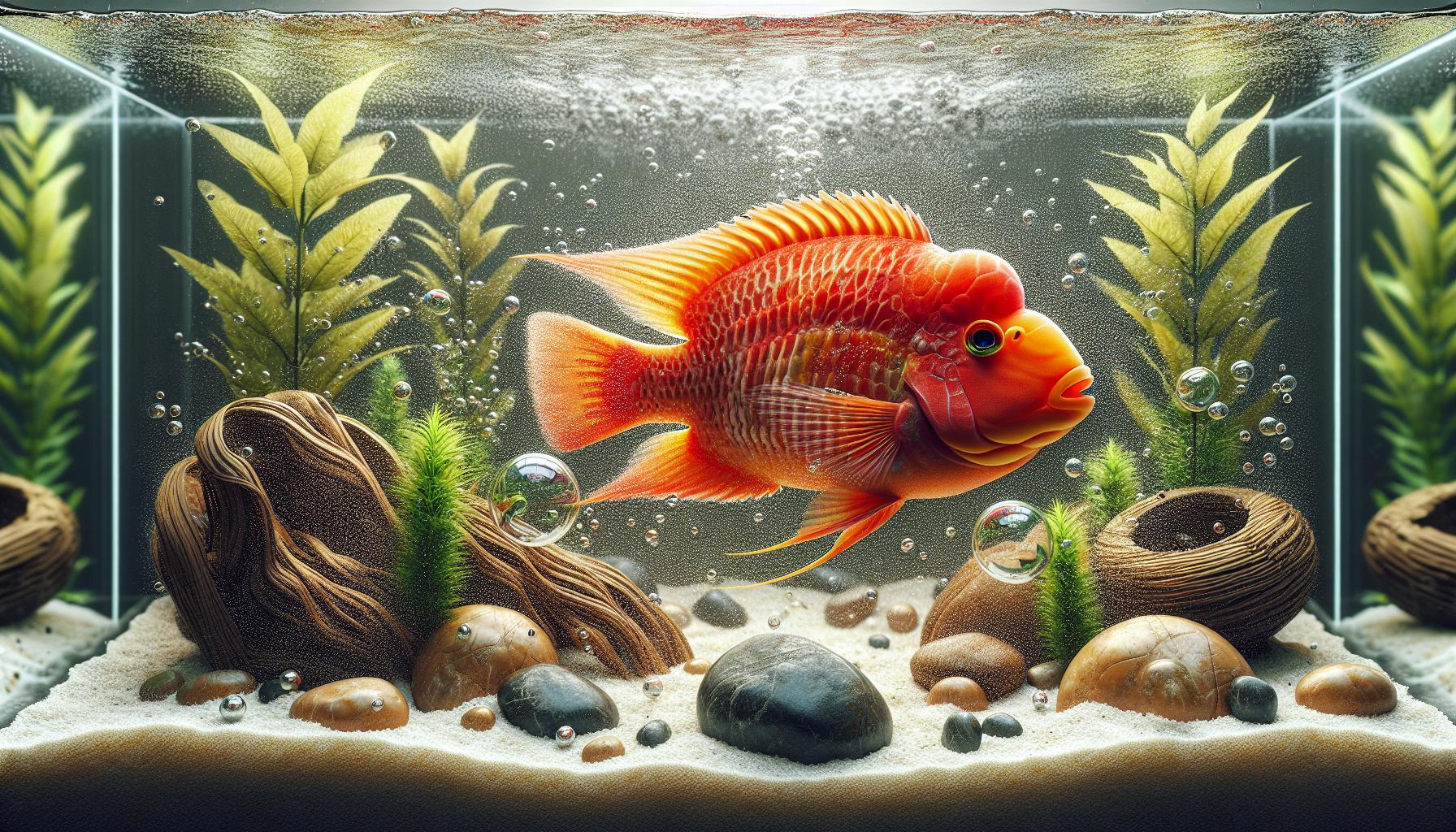
Delving into the Origins of the Blood Parrot Cichlid, I’ve come to find a tale as vibrant as the fish itself. This unique hybrid first made its appearance in the aquarium scene in the late 1980s, stirring both intrigue and controversy amongst enthusiasts and experts alike. It’s believed that the Blood Parrot Cichlid emerged from crossbreeding the Midas Cichlid (Amphilophus citrinellus) and the Redhead Cichlid (Paraneetroplus synspilus). However, the exact lineage remains somewhat shrouded in mystery, with theories suggesting alternative parentage from other Cichlid species.
What’s undeniable is the distinctive appearance and demeanor this breeding has imparted on the Blood Parrot Cichlid. Their vivid coloration, ranging from intense oranges to fiery reds, coupled with a unique body shape, often draws immediate attention. Their physical form, characterized by a rounded body and a beak-like mouth, distinguishes them from other Cichlid varieties. However, it’s worth noting that their mouth structure, seen by some as a defining charm, also poses feeding challenges and sparks a piece of the ethical debate surrounding their creation.
From an ethical standpoint, the breeding practices that led to the Blood Parrot Cichlid’s existence have been met with criticism. Concerns about the health and welfare of these hybrids are at the forefront of discussions. Despite these concerns, their popularity in home aquariums has only grown, with many arguing that responsible care can mitigate potential health issues.
The controversy surrounding the Blood Parrot Cichlid only adds layers to their intrigue. As a hybrid species, they don’t exist in the wild, which makes the care and propagation of these fish within aquaria all the more critical for their survival. Their ability to thrive and interact within a captive environment is a testament to the successful, though debated, blending of genetic traits.
Exploring the origins and the debates surrounding the Blood Parrot Cichlid has led me to appreciate the complexity and beauty of these creatures even more. They represent a fascinating chapter in the world of ornamental fish, highlighting the balance between human creativity and nature. Their colorful presence in an aquarium can’t help but capture the admiration of anyone who looks upon them, inviting ongoing discussions about ethics, care, and conservation in the hobby.
The Controversy Surrounding Blood Parrot Cichlids
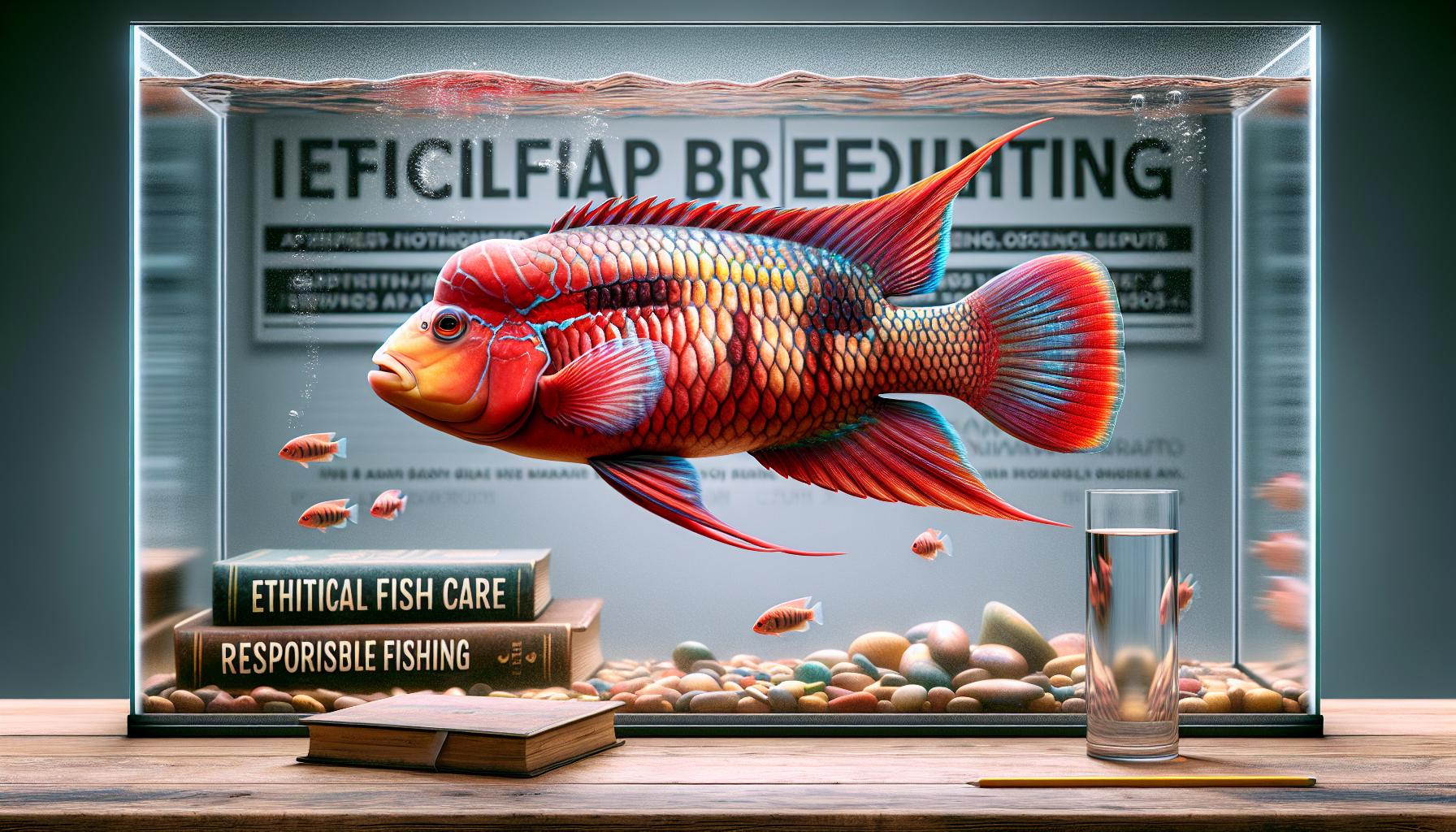
When diving into the world of Blood Parrot Cichlids, it’s impossible for me to overlook the heated debates that encircle these vibrant creatures. At the heart of the controversy lies the practice of hybridization. Critics argue that the breeding process that creates Blood Parrot Cichlids often leads to significant health and welfare issues. I’ve seen firsthand how their distinctive physical features, particularly the unique shape of their mouth, can sometimes result in feeding and breathing difficulties.
Moreover, ethical concerns play a huge role in the debate. Some members of the fishkeeping community feel that creating a fish purely for its aesthetic value, without regard for its well-being, crosses a line. The manipulation of species to produce a certain look – in this case, a bright color and peculiar body shape – raises questions about our responsibilities toward these living creatures.
Despite these concerns, there’s a significant portion of the aquarium hobby that embraces Blood Parrot Cichlids. Proponents argue that with proper care, many of the health issues can be mitigated. They emphasize the importance of buying fish from reputable breeders who prioritize the health and wellness of their fish.
I’ve also noticed an intriguing shift toward more ethical breeding practices. Some breeders are now focusing on creating healthier Blood Parrots that suffer fewer health complications, suggesting that the community might be moving towards a more responsible approach to keeping these fish.
The debate around Blood Parrot Cichlids is complex, touching on issues of animal welfare, ethics, and the future of the aquarium hobby. As someone immersed in this world, I find these discussions vital for understanding how we can balance our desire for beautiful aquariums with the well-being of the fish we choose to keep.
The Appearance of the Blood Parrot Cichlid
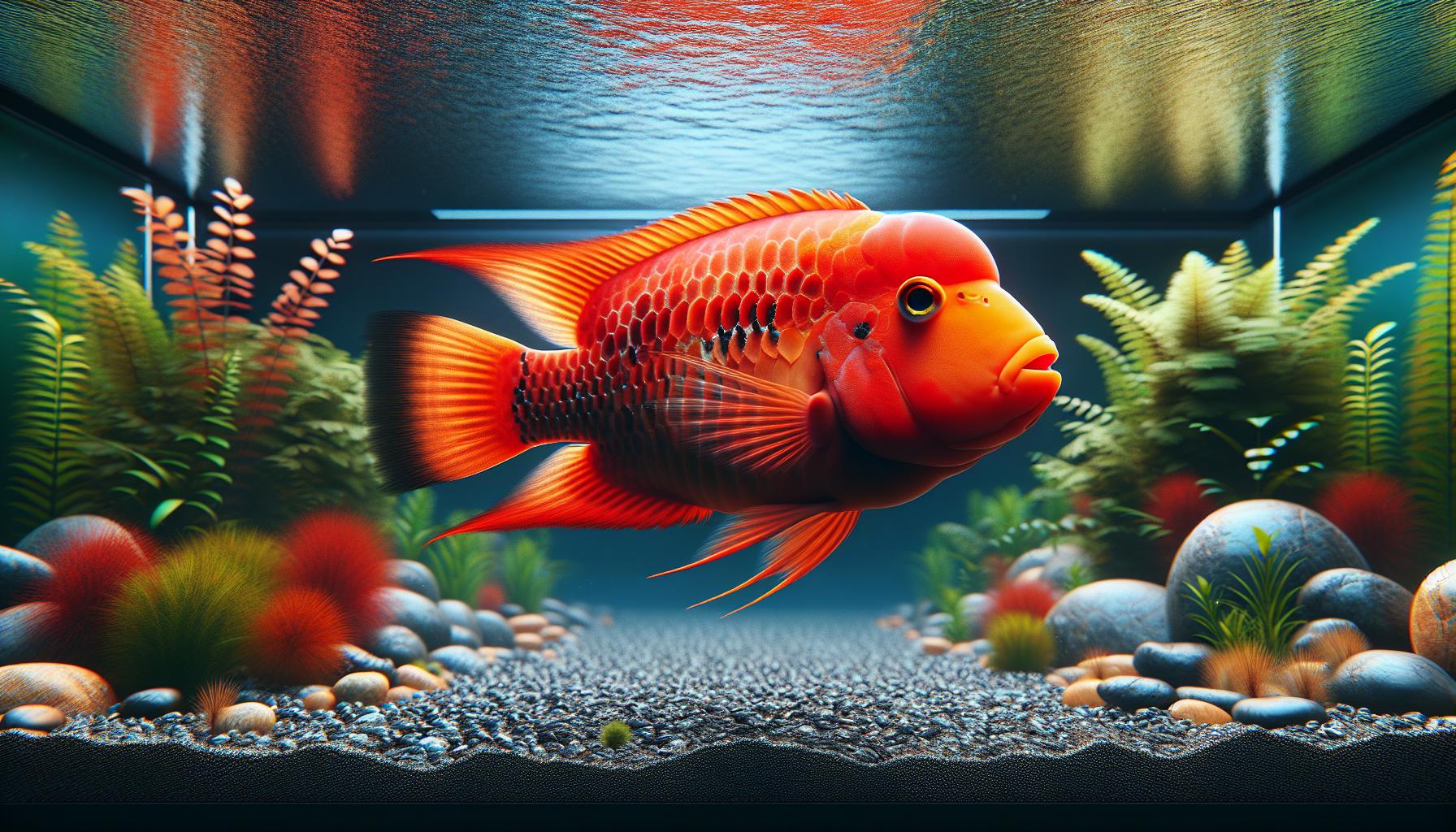
When first laying eyes on a Blood Parrot Cichlid, you’re likely struck by its vivid colors and unique shape. These hybrids showcase a rainbow of colors ranging from bright oranges to deep reds, making them a visual standout in any aquarium. What’s more, their coloration is not just skin-deep. I’ve noticed that these fish can change hues based on their health status or mood, a fascinating aspect that adds an extra layer of interaction for the attentive aquarist.
The body shape of the Blood Parrot Cichlid is another point of interest. They possess a round, parrot-like beak, which is not found in other cichlids and contributes to their name. However, this distinctive beak is at the heart of much controversy. It’s the result of selective breeding and is known to cause feeding difficulties. Despite this, I’ve found that with the right diet and care, Blood Parrot Cichlids can live fulfilling lives. Their swim bladders are also affected by selective breeding, sometimes leading to unique swimming patterns that are both charming and disconcerting.
Given their robust size, usually reaching up to 8 inches in length, these creatures demand a sizable aquarium. They thrive in environments where they can explore and interact with various elements. Over the years, I’ve learned that providing them with ample space is crucial for their well-being, allowing them to express natural behaviors and maintain good health.
Diving into the specifics, here’s a quick overview of their distinctive features:
- Color: Ranges from bright oranges to deep reds
- Shape: Round body with a parrot-like beak
- Size: Up to 8 inches in length
Understanding the appearance of the Blood Parrot Cichlid is key to appreciating their place in the aquarium community. Their unique aesthetic, combined with their intriguing behaviors, makes them an attractive yet controversial addition. As we continue this exploration, it’s important to weigh the beauty they bring to our tanks against the ethical considerations their existence raises.
Unique Traits and Behaviors of Blood Parrot Cichlids
Blood Parrot Cichlids stand out in the world of freshwater aquariums, not just for their vivid hues but also for their distinctive behaviors and physical traits. When I first began keeping these fascinating fish, I was immediately struck by their social nature. They exhibit a level of intelligence and social interaction uncommon in many other fish species, making them a captivating subject for any fish enthusiast.
Vivid Colors and Shape
One of the most striking features of Blood Parrot Cichlids is their bold colors, ranging from bright oranges to deep reds. Their coloration isn’t just for show; it can also serve as an indicator of their health and mood. A healthy Blood Parrot Cichlid will boast a vibrant hue, while stress or illness may cause their colors to fade. This makes observing their coloration an essential part of their care.
Their body shape is another unique trait. They possess a round, balloon-like body and a beak-shaped mouth, which, while contributing to their appeal, has sparked controversy due to the health issues it can cause. Their distinctive mouth shape can make feeding a challenge, so it’s crucial to provide them with suitable food that’s easy for them to consume.
Behavior and Social Interaction
Blood Parrot Cichlids are incredibly social creatures. They thrive in groups and often form close bonds with their tank mates. I’ve noticed that they display a wide range of emotions and can even exhibit playful behavior, such as gently nudging each other or swimming in intricate patterns. It’s this level of interaction that sets them apart from many other species and makes watching them an endlessly fascinating experience.
Moreover, they can be quite territorial, especially during breeding season. Establishing a spacious and well-structured environment is key to managing their territorial instincts and ensuring harmony within the tank.
Caring for Blood Parrot Cichlids: Tips and Best Practices
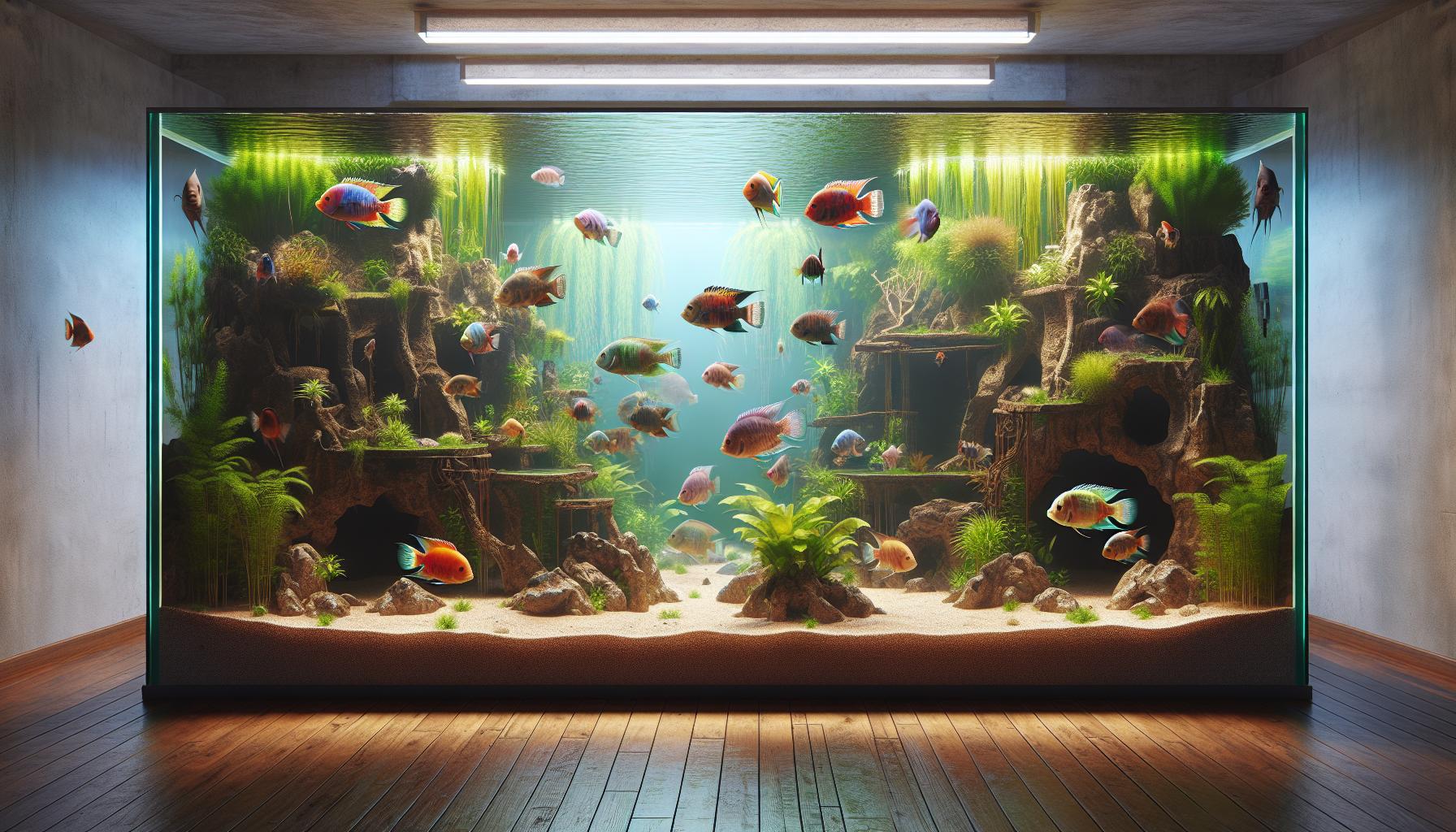
Caring for Blood Parrot Cichlids requires understanding and patience, given their unique needs. Having kept these vibrant fish in my own aquarium for years, I’ve compiled some essential tips and best practices that ensure a healthy, thriving environment for them.
Water Quality and Temperature
First and foremost, maintaining excellent water quality is non-negotiable. Blood Parrot Cichlids are sensitive to poor water conditions, so I can’t stress enough the importance of regular water changes and monitoring. Aim for a weekly change of 20-25% of the water to keep nitrate levels low. The perfect water temperature range for these fish is between 76°F and 80°F. Consistent water parameters prevent stress, promoting better health and coloration in these fish.
Aquarium Size and Setup
Space is critical for these active fish. A single Blood Parrot Cichlid needs at least a 30-gallon tank, but if you’re planning to keep a group, I’d recommend starting with a 75-gallon tank or larger. They appreciate a setup with plenty of hiding spots and room to swim. Structured environments with caves and plants mimic their natural habitat and provide a sense of security.
Diet and Feeding
Due to their unique mouth shape, feeding Blood Parrot Cichlids can be challenging. They benefit from a varied diet of pellets designed for cichlids, frozen foods, and occasional live snacks. I’ve found that sinking pellets are easier for them to eat. It’s vital to ensure the food pieces are small enough for their mouths. Feeding them twice a day in small amounts prevents overfeeding and promotes better digestive health.
Social Behavior and Tank Companions
Blood Parrot Cichlids have a peaceful temperament but can display territorial behaviors, especially during breeding season. They generally do well with other fish of similar size and temperament. However, it’s essential to monitor their interactions and provide enough space for each fish to claim its territory. Avoid overly aggressive species that might bully or stress your Blood Parrots.
By adhering to these tips and best practices, I’ve seen significant positive changes in the health and happiness of my Blood Parrot Cichlids. Proper care leads to a vibrant and lively aquarium community, making the extra effort well worth it.
Compatible Tank Mates for Blood Parrot Cichlids

Choosing the right tank mates for Blood Parrot Cichlids is essential for creating a harmonious and thriving aquarium environment. Due to their unique temperament and size, not all fish are suitable companions for these vibrant cichlids. I’ve found that selecting the right species can significantly impact the well-being and happiness of your aquarium inhabitants.
Firstly, mid-sized peaceful fish make the best companions for Blood Parrot Cichlids. These fish are often able to hold their own without provoking or being harassed by the cichlids. Species such as mollies, platies, and some types of tetras can adapt well to the environment required by Blood Parrot Cichlids. It’s crucial to avoid very small fish that could be seen as prey and aggressive fish that could stress or injure your cichlids.
Larger, peace-loving bottom-dwellers like the Bristlenose Pleco or various Corydoras species also make excellent tank mates. They occupy different levels of the tank, which helps reduce competition for space and resources. This diversity not only makes your aquarium more visually appealing but also promotes a more dynamic ecosystem.
Another important consideration is maintaining a balanced gender ratio among your Blood Parrots if you’re keeping more than one. A mix that leans heavily towards males can lead to territorial disputes, so aiming for a more female-heavy group can foster a more peaceful tank environment.
Here’s a quick reference list of compatible tank mates for Blood Parrot Cichlids:
- Mollies
- Platies
- Tetras (larger species)
- Bristlenose Pleco
- Corydoras species
Remember, when introducing any new fish to your aquarium, it’s vital to do so gradually and monitor interactions closely. Proper acclimation and observation can prevent potential conflicts and ensure a healthy, vibrant community aquarium.
Breeding Blood Parrot Cichlids
Breeding Blood Parrot Cichlids comes with its own set of challenges and controversies. Initially, it’s essential to recognize that many Blood Parrots are sterile, meaning they’re incapable of breeding. However, some cases have reported successful breeding, often requiring intervention or the presence of a closely related cichlid species to facilitate the process.
Creating the Right Environment is crucial for those who intend to try their hand at breeding these unique fish. The aquarium should mimic their natural habitat as closely as possible. This means maintaining water temperatures between 76-80°F and ensuring the water pH stays within a neutral range of 6.5-7.4. A spacious tank is non-negotiable, as crowding can stress fish, impacting their health and the likelihood of successful breeding.
Additionally, providing hiding spaces and territories within the tank through strategic placement of rocks and caves can encourage natural breeding behaviors. Since Blood Parrot Cichlids can be territorial, especially during the breeding season, such arrangements help in managing aggression, ensuring a safer environment for all fish involved.
The actual process of breeding might require patience and keen observation. During the breeding phase, the male displays vibrant colors and engages in a dance to attract the female. If the female is receptive, she lays eggs in a secure spot, typically a flat surface or a secluded cave, where the male then fertilizes them. It’s important to note that in the absence of a fertile male, females may still lay unfertilized eggs.
Feeding plays a pivotal role in breeding Blood Parrot Cichlids. High-quality foods rich in protein, like brine shrimp, bloodworms, and specialized cichlid pellets, can enhance their health and vitality, potentially increasing the chances of successful breeding.
Despite the challenges, the endeavor of breeding Blood Parrot Cichlids can be rewarding. It offers a deeper dive into understanding the complex behaviors and needs of these magnificent creatures.
Common Health Issues and How to Prevent Them
When caring for Blood Parrot Cichlids, I’ve found that prevention is the key to maintaining their health. These fish can face several health issues, but with proper care, most problems can be avoided. Here, I’ll dive into some of the common health issues and how to prevent them.
Ich or White Spot Disease is a frequent concern among Blood Parrot Cichlids. This parasitic infection manifests as white spots on the fish’s body and fins. Maintaining optimal water quality and keeping the water temperature stable can significantly reduce the risk of Ich. Regular water changes and the use of a reliable aquarium heater can make a world of difference.
Swim Bladder Disorder, characterized by the fish swimming at odd angles or struggling to maintain buoyancy, is another issue. This can often be attributed to poor diet or rapid changes in water temperature. Feeding them a balanced diet and avoiding overfeeding are vital. Also, gradually adjusting the water temperature during changes helps prevent this disorder.
Blood Parrot Cichlids can also suffer from Skin and Fin Rot, symptoms of which include frayed or discolored fins. This bacterial infection is usually a result of poor water conditions. Regular tank cleaning and monitoring the tank’s ammonia, nitrite, and nitrate levels can prevent most cases.
| Common Health Issues | Prevention Strategies |
|---|---|
| Ich (White Spot Disease) | Optimal water quality, stable water temperature |
| Swim Bladder Disorder | Balanced diet, gradual water temperature changes |
| Skin and Fin Rot | Regular tank cleaning, monitor ammonia, nitrite, nitrate levels |
By emphasizing preventative care, I’ve managed to keep my Blood Parrot Cichlids healthy and vibrant. It’s crucial for anyone considering these unique fish to understand the importance of regular tank maintenance, proper diet, and environmental stability to prevent common health issues.
Conclusion
Caring for Blood Parrot Cichlids is both a challenge and a joy. Their vibrant colors and unique personalities make them a fascinating addition to any aquarium. Yet, their well-being hinges on our understanding and commitment to their specific needs. From ensuring the right tank conditions to providing a balanced diet and managing their social interactions, every aspect of their care is crucial. It’s essential to approach their breeding with caution, given the ethical considerations and health implications. By focusing on preventive care and creating a stable environment, we can help these beautiful creatures thrive. Embracing the responsibility that comes with keeping Blood Parrot Cichlids means we’re not just fishkeepers; we’re guardians of their well-being.
Frequently Asked Questions
What are Blood Parrot Cichlids?
Blood Parrot Cichlids are a hybrid species of fish known for their vivid colors, unique shape, and the ability to change hues based on their health or mood. Selectively bred for their distinctive appearance, they have certain physical characteristics, like a beak-shaped mouth, that can cause health issues, including feeding difficulties.
Why are there ethical concerns about Blood Parrot Cichlids?
The ethical concerns surrounding Blood Parrot Cichlids stem from their breeding process. Their unique physical features, like the beak-shaped mouth and swim bladder issues, are results of selective breeding, which can lead to health problems and feeding difficulties, raising questions about the ethics of their creation.
How should Blood Parrot Cichlids be cared for?
Caring for Blood Parrot Cichlids involves maintaining high water quality and temperature, providing a suitable aquarium size and setup, ensuring a proper diet and feeding routine, and understanding their need for social interaction. It’s also crucial to select compatible tank mates and maintain a balanced gender ratio to prevent territorial disputes.
What are some common health issues for Blood Parrot Cichlids?
Common health issues include Ich or White Spot Disease, Swim Bladder Disorder, and Skin and Fin Rot. Prevention strategies involve maintaining optimal water quality, stable water temperature, feeding a balanced diet, avoiding overfeeding, and keeping the tank clean and well-monitored for ammonia, nitrite, and nitrate levels.
Can Blood Parrot Cichlids be bred successfully?
Breeding Blood Parrot Cichlids can be challenging due to their sterility. Success may require intervention or the presence of a closely related cichlid species. Creating the right environment, including appropriate water temperature and pH levels, a spacious tank, and providing hiding spaces and territories, is key to encouraging breeding efforts.

